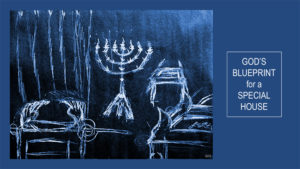 As soon as the covenant between God and Israel was consummated, God immediately instructed Israel to build a special house that He could dwell in.
As soon as the covenant between God and Israel was consummated, God immediately instructed Israel to build a special house that He could dwell in.
“And let them construct a sanctuary for Me, that I may dwell among them”. (Exodus 25:8)
Later God declared that He had brought Israel out of Egypt for this very purpose.
“And they shall know that I am the Lord their God who brought them out of the land of Egypt, that I might dwell among them; I am the Lord their God.” (Exodus 29:46)
There are many explanations for God bringing Israel out of Egypt but this is His explicitly stated reason. He desires to dwell in the midst of the human community on planet earth. That plan has not changed throughout the ages.
The plans for the tabernacle and its implements are the first revelation of the church that we find in the Bible. Certainly there had already been patterns revealed concerning the Messiah, but the special house foreshadows the real church (in contrast to the institutional church). God instructed Moses to build the tabernacle according to the plan shown him on the mountain.
“And you shall erect the tabernacle according to its plan which you have been shown in the mountain”. (Exodus 26:30)
How did God show a pattern to Moses? Of course, I am speculating at this point, but I believe we get a glimpse of the process by which prophecy comes about. I believe God showed Moses a vision of a future event or situation. In this case I believe that God showed him the New Creation which would be described by the Apostle John (Revelation 21-22). The Most Holy Place of the tabernacle has the same configuration and purpose as the city, New Jerusalem. According to John, the city of New Jerusalem and the redeemed Church are one and the same.
“And one of the seven angels who had the seven bowls full of the seven last plagues came and spoke with me, saying, “Come here, I will show you the bride, the wife of the Lamb.” And he carried me away in the Spirit to a great and high mountain, and showed me the holy city, Jerusalem, coming down out of heaven from God,…” (Revelation 21:9-10)
The city, New Jerusalem, is the dwelling place of the Holy One and the Lamb (Revelation 22:3b). In the original tabernacle, the Most Holy Place was the throne of God. The outer chamber, the Holy Place, was the throne (ministry) of the Messiah. After the death and resurrection of Messiah Jesus, the Lamb’s throne is also located within the Most Holy Place. This is the reason the veil was torn from top to bottom at the death of Messiah Jesus.
The Ark of the Covenant that was constructed for the tabernacle represents the throne of God. The Ark was a relatively small box made of wood and overlaid with gold. The top of the box was similarly constructed. As a part of the gold overlay of the top were two golden “cherubim” (angelic figures). The top was the place of covering. Blood would be sprinkled there for the covering of sin. The Hebrew name for the top is “Hakaporet”, or the covering.
“For the life of the flesh is in the blood, and I have given it to you on the altar to make atonement for your souls; for it is the blood by reason of the life that makes atonement.” (Leviticus 17:11)
One final thought from this section, the Cherubim on the either side of God’s throne were facing one another and looking downward toward (pointing to) the throne of God. The previous reference to the Cherubim was in the “garden account”.
“So He drove the man out; and at the east of the garden of Eden He stationed the cherubim and the flaming sword which turned every direction to guard the way to the tree of life”. (Genesis 3:24)
The former ministry of the Cherubim was to declare that man cannot approach God on his own. Now the Cherubim are declaring the one approach to God. When the tabernacle was completed, the singular approach to God would be: (a) through the camp of Israel, (b) in the Eastern gate of the tabernacle, (c) past the bronze altar (covering for sin), (d) past the laver (cleansing), (e) in the Holy Place (ministry of Messiah) and finally, (f) into the Most Holy Place to the presence of God (the Tree of Life). This is what Jesus was declaring when He said:
“Jesus said to him, “”I am the way, and the truth, and the life, no one comes to the Father but through Me.” (John 14:6)
Today the institutional church separates Jesus the Messiah from the camp of Israel. However, Messiah is an office in Israel. To fruitfully follow the Messiah today, we still need to enter through the camp of Israel. This is the significance of “Hebraic Roots”.
(Copies of my book “Hebraic Roots” are available through the Tzemach Institute for Biblical Studies in Winter Springs, Florida).